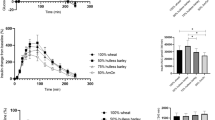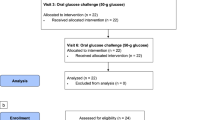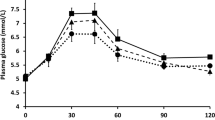Abstract
Objective:
To determine the impact of the form, fibre content, baking and processing on the glycaemic, insulinaemic and lipidaemic responses of different French breads.
Design and Subjects:
First study: Nine healthy subjects were randomized to consume in a crossover design one of six kinds of French bread (each containing 50 g available carbohydrate): classic baguette, traditional baguette, loaf of wholemeal bread (WM-B), loaf of bread fermented with yeast or with leaven, a sandwich and a glucose challenge as reference.
Results:
The glycaemic index (GI) values ranged from 57±9% (mean±s.e.m.), for the traditional baguette, to 85±27% for the WM-B. No significant difference was found among the different tested bread. The insulinaemic index (II), however, of the traditional baguette and of the bread fermented with leaven were lower than the other breads (analysis of variance: P<0.01). Postprandial plasma triglycerides showed similar profiles. The traditional baguette tended to decrease postprandial free fatty acids compared to levels after the classic baguette.
Results:
The GI of the traditional baguette was lower than that of the classic baguette (n=8, venous blood: 70±4 vs 75±4, P=0.002; capillary blood: 69±5 vs 83±6, P=0.028, respectively).
Conclusions:
Some varieties of French bread (the TB) have lower II, in healthy subjects, and lower GI, in type 2 diabetic subjects, than that of the other varieties. These results might be due to bread processing difference rather than fibre content.
Sponsorships:
Supported by grants from the National French Milling Association.
Second study, we aimed to re-evaluate the values of the GI of the classic and traditional French baguettes (TB) in another population (type 2 diabetics, n=9).
This is a preview of subscription content, access via your institution
Access options
Subscribe to this journal
Receive 12 print issues and online access
$259.00 per year
only $21.58 per issue
Buy this article
- Purchase on Springer Link
- Instant access to full article PDF
Prices may be subject to local taxes which are calculated during checkout


Similar content being viewed by others

References
Bonora E, Muggeo M (2001). Postprandial blood glucose as a risk factor for cardiovascular disease in Type II diabetes: the epidemiological evidence. Diabetologia 44, 2107–2114.
Bornet FRJ, Costagliola D, Rizkalla SW, Blayo A, Fontvieille AM, Haardt MJ et al. (1987). Insulinemic and glycemic indexes of six starch-rich foods taken alone and in a mixed meal by type 2 diabetes. Am J Clin Nutr 45, 588–595.
Brouns F, Bjorck IE, Frayn K, Gibbs A, Lang V, Slama G et al. (2005). Glycaemic index methodology. Nutr Res Rev 18, 145–171.
Champ M, Martin L, Noah L, Gratas M (1999). Analytical methods for resistant starch. In: Cho SS, Prosky L and Dreher M (ed). Complex Carbohydrates in Foods. M Marcel Dekker Inc.: NY, USA, pp 169–187.
Chandalia M, Garg A, Lutjohann D, von Bergmann K, Grundy SM, Brinkley LJ (2000). Beneficial effects of high dietary fiber intake in patients with type 2 diabetes mellitus. N Engl J Med 342, 1392–1398.
Documenta-Geigy (1972). Table Scientifiques, 7th edn, Ciba-Geigy: Basle.
Faisant N, Planchot V, Kozlowski F, Pacouret MP, Colonna P, Champ M (1995). Resistant starch determination adapted to products containing high level of resistant starch. Sci Aliments 15, 83–89.
FAO/WHO (1998). Carbohydrates in Human Nutrition Report of a Joint FAO/World Health Organization Expert Consultation: FAO Food and Nutrition, p 66.
Foster-Powell K, Holt SH, Brand-Miller JC (2002). International table of glycemic index and glycemic load values. Am J Clin Nutr 76, 5–56.
Giacco R, Parillo M, Rivellese AA, Lasorella G, Giacco A, D'Episcopo L et al. (2000). Long-term dietary treatment with increased amounts of fiber-rich low-glycemic index natural foods improves blood glucose control and reduces the number of hypoglycemic events in type 1 diabetic patients. Diabetes Care 23, 1461–1466.
Granfeldt YE, Wu X, Bjorck IME (2006). Determination of glycaemic index; some methodological aspects related to the analysis of carbohydrate load and characteristics of the previous evening meal. Eur J Clin Nutr 60, 104–112.
Holt SH, Brand J, Soveny C, Hansky J (1992). Relationship of satiety to postprandial glycaemic, insulin and cholecystokinin responses. Appetite 18, 129–141.
Jenkins DJ, Kendall CW, Augustin LS, Vuksan V (2002). High-complex carbohydrate or lente carbohydrate foods? Am J Med 113 (Suppl 9B), 30S–37S.
Jenkins DJA, Wolever TMS, Leeds AR, Gassull MA, Dilwari JB, Haisman P et al. (1978). Dietary fibers, fiber analogues and glucose tolerance: importance of viscosity. BMJ 1, 1392–1394.
Jimenez-Cruz A, Turnbull WH, Bacardi-Gascon M, Rosales-Garay P (2004). A high-fiber, moderate-glycemic-index, mexican style diet improves dyslipidemia in individuals with type 2 diabetes. Nutr Res 24, 19–27.
Juntunen KS, Laaksonen DE, Autio K, Niskanen LK, Holst JJ, Savolainen KE et al. (2003a). Structural differences between rye and wheat breads but not total fiber content may explain the lower postprandial insulin response to rye bread. Am J Clin Nutr 78, 957–964.
Juntunen KS, Laaksonen DE, Poutanen KS, Niskanen LK, Mykkanen HM (2003b). High-fiber rye bread and insulin secretion and sensitivity in healthy postmenopausal women. Am J Clin Nutr 77, 385–391.
Kiens B, Richter EA (1996). Types of carbohydrate in an ordinary diet affect insulin action and muscle substrates in humans. Am J Clin Nutr 63, 47–53.
Liljeberg HG, Bjorck IM (1996). Delayed gastric emptying rate as a potential mechanism for lowered glycemia after eating sourdough bread: studies in humans and rats using test products with added organic acids or an organic salt. Am J Clin Nutr 64, 886–893.
Liu S, Manson JE, Stampfer MJ, Hu FB, Giovannucci E, Colditz GA et al. (2000a). A prospective study of whole-grain intake and risk of type 2 diabetes mellitus in US women. Am J Public Health 90, 1409–1415.
Liu S, Willet WC, Stampfer MJ, Hu FB, Franz M, Sampson L et al. (2000b). Prospective study of dietary glycemic load, carbohydrate intake, and risk of coronary heart disease in US women. Am J Ciln Nutr 71, 1455–1461.
Liu S, Willett WC, Manson JE, Hu FB, Rosner B, Colditz G (2003). Relation between changes in intakes of dietary fiber and grain products and changes in weight and development of obesity among middle-aged women. Am J Clin Nutr 78, 920–927.
Ludwig DS (2002). The glycemic index: physiological mechanisms relating to obesity, diabetes, and cardiovascular disease. JAMA 287, 2414–2423.
Mann JI, De Leeuw I, Hermansen K, Karamanos B, Karlstrom B, Katsilambros N et al. (2004). Evidence-based nutritional approaches to the treatment and prevention of diabetes mellitus. Nutr Metab Cardiovasc Dis 14, 373–394.
Ostman E, Granfeldt YE, Persson L, Bjorck IE (2005). Vinegar supplementation lowers glucose and insulin responses and increases satiety after a bread meal in healthy subjects. Eur J Clin Nutr 59, 983–988.
Pawlak DB, Kushner JA, Ludwig DS (2004). Effects of dietary glycaemic index on adiposity, glucose homoeostasis, and plasma lipids in animals. Lancet 364, 778–785.
Robertson MD, Currie JM, Morgan LM, Jewell DP, Frayn KN (2003). Prior short-term consumption of resistant starch enhances postprandial insulin sensitivity in healthy subjects. Diabetologia 46, 659–665.
Slavin JL, Jacobs D, Marquart L (2001). Grain processing and nutrition. Crit Rev Biotechnol 21, 49–66.
USD (2000). Nutrition and Your Health: Dietary Guidelines for Americans 5th edn US Department of Agriculture, US Department of Health and Human Services: Washington, DC.
Weickert MO, Mohlig M, Koebnick C, Holst JO, Namsolleck P, Ristow M et al. (2005). Impact of cereal fibre on glucose-regulating factors. Diabetologia 48, 2343–2353.
Wolever TM (2004). Effect of blood sampling schedule and method of calculating the area under the curve on validity and precision of glycaemic index values. Br J Nutr 91, 295–301.
Wolever TM, Vorster HH, Bjorck IE, Brand-Miller J, Brighenti F, Mann JI et al. (2003). Determination of the glycaemic index of foods: interlaboratory study. Eur J Clin Nutr 57, 475–482.
Acknowledgements
The financial support from the National French Milling Association to conduct this work is gratefully acknowledged. We acknowledge the Director of Hôtel Dieu Hospital for giving the permission to conduct the study. We also thank the medical and non medical staff of the Department of Diabetes for their assistance.
Author information
Authors and Affiliations
Corresponding author
Additional information
Guarantor: G Slama.
Contributors: SWR conceived the overall study, was responsible for planning the study and drafted the manuscript. FB and JB did the analytical and statistical analysis. ML was responsible for lipid analysis. MC was responsible for the analytical procedures of resistant starch. All contributors helped with the revision of the paper.
Rights and permissions
About this article
Cite this article
Rizkalla, S., Laromiguiere, M., Champ, M. et al. Effect of baking process on postprandial metabolic consequences: randomized trials in normal and type 2 diabetic subjects. Eur J Clin Nutr 61, 175–183 (2007). https://doi.org/10.1038/sj.ejcn.1602514
Received:
Revised:
Accepted:
Published:
Issue Date:
DOI: https://doi.org/10.1038/sj.ejcn.1602514
Keywords
This article is cited by
-
Advanced glycation end products (AGEs) are cross-sectionally associated with insulin secretion in healthy subjects
Amino Acids (2014)
-
Effect of consumption of micronutrient enriched wheat steamed bread on postprandial plasma glucose in healthy and type 2 diabetic subjects
Nutrition Journal (2013)
-
Effects of two different types of fast food on postprandial metabolism in normal and overweight subjects
European Journal of Clinical Nutrition (2012)
-
Sourdough fermentation as a tool for the manufacture of low-glycemic index white wheat bread enriched in dietary fibre
European Food Research and Technology (2009)


